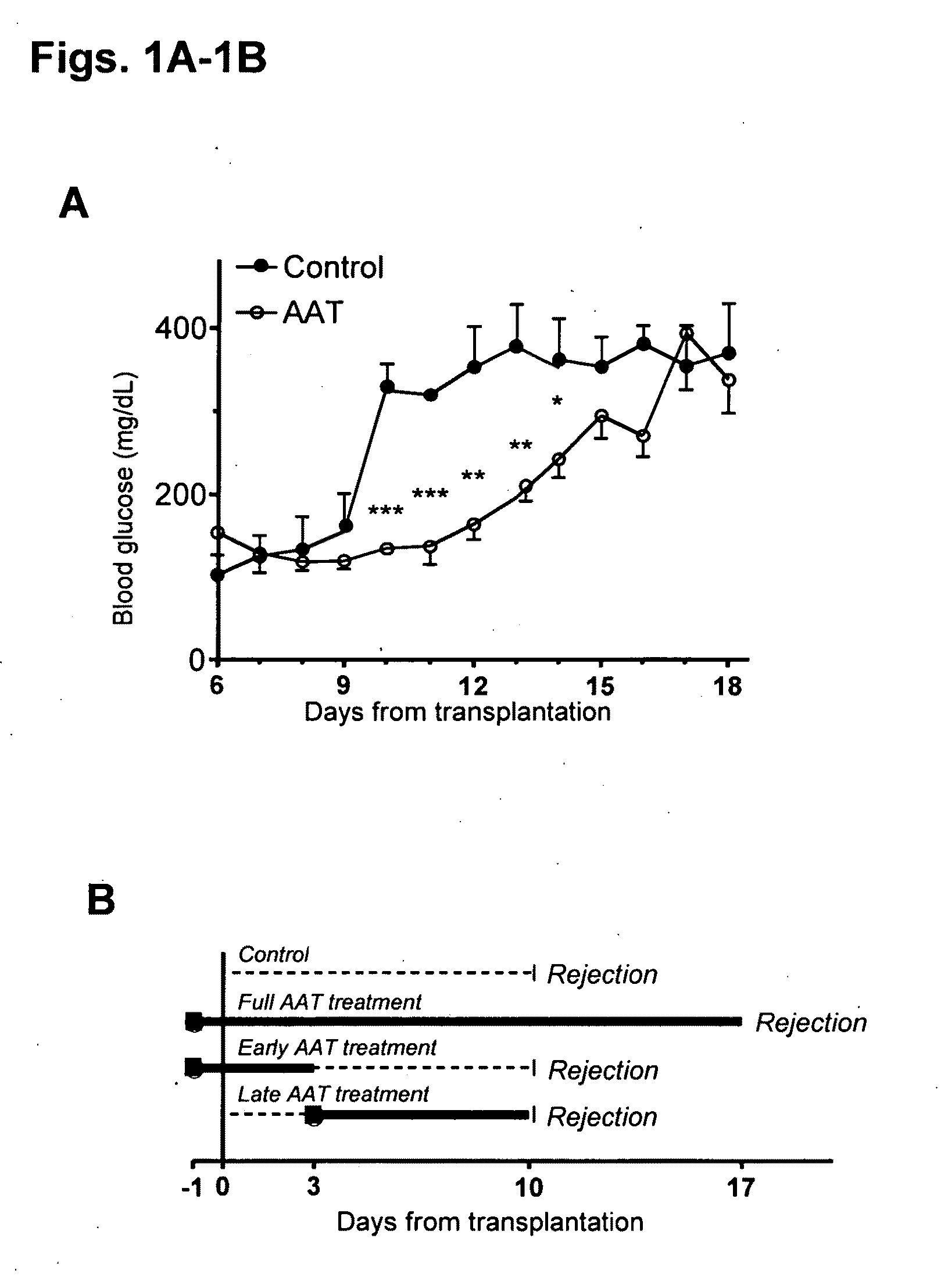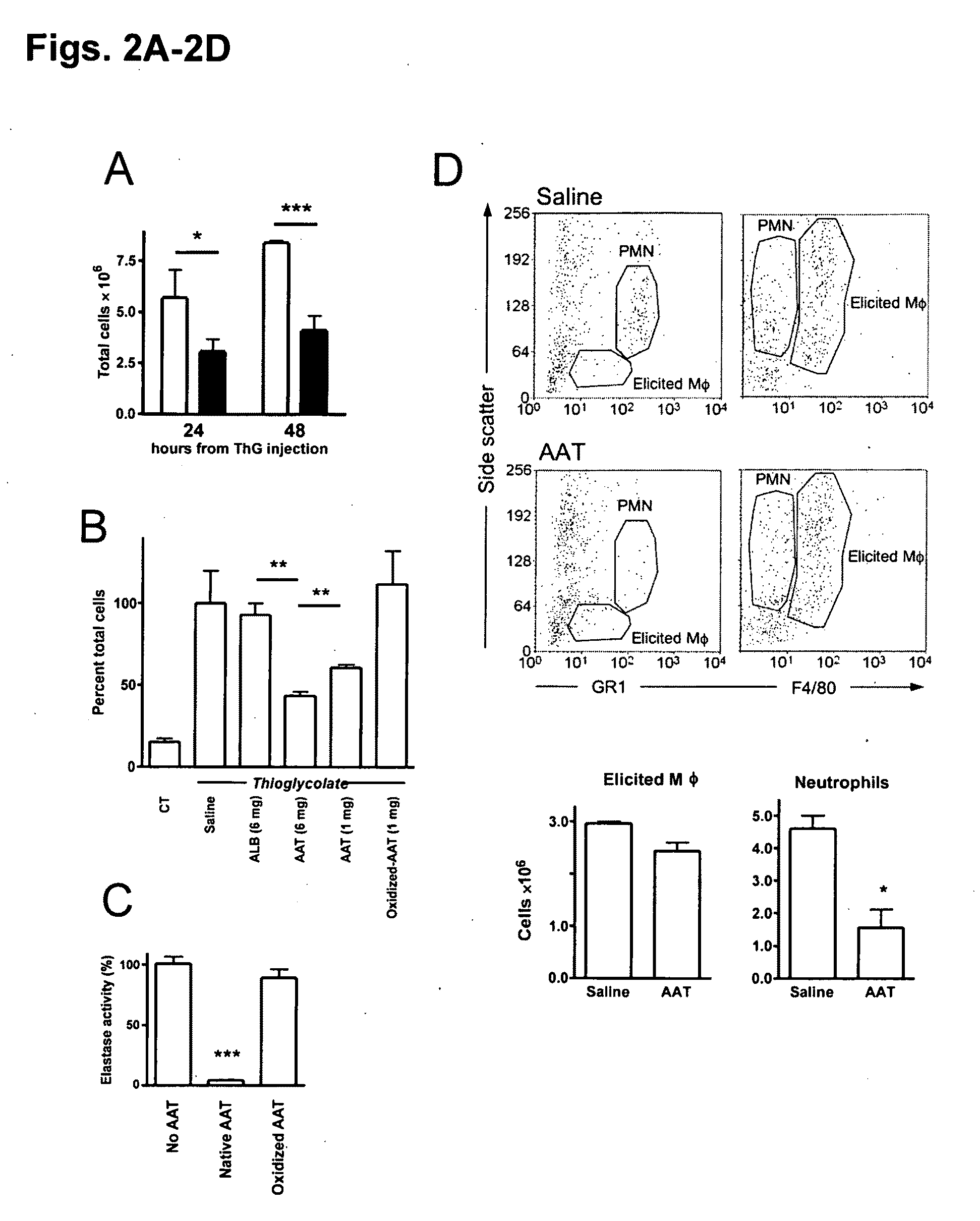Compositions and methods of use for alpha-1 antitrypsin having no significant serine protease inhibitor activity
a technology of serine protease inhibitor and alpha-1 antitrypsin, which is applied in the field of alpha1 antitrypsin (1 antitrypsin, aat), can solve the problems of the host immune system's damage to the transplantation effect, reduce the risk of transplantation rejection, reduce or eliminate the risk of graft rejection and/or cell rejection
- Summary
- Abstract
- Description
- Claims
- Application Information
AI Technical Summary
Benefits of technology
Problems solved by technology
Method used
Image
Examples
example 1
Alpha-1-Antitrypsin Prolongs Graft Islet Graft Survival in Mice
[0201]FIG. 1A-1D. Islets from DBA / 2 mice (H-2d) were transplanted under the renal capsule of streptozotocin-induced hyperglycemic C57BL / 6 mice (H-2b). (A) Glucose levels from days 6-18. Control consists of mice that were untreated (n=3) or treated from day −1 every 3 days with human albumin (ALB, 6 mg, n=3). Prolonged islet graft survival is observed in mice treated from day −1 every 3 days with human AAT (2 mg, n=10). *P<0.05, **P<0.01, ***P<0.001 between glucose levels on same day. (B) Treatment protocols. Control and full AAT treatment are described in panel A. Early AAT treatment consists of treatment on days −1, 1 and 3 (2 mg, n=3). Late AAT treatment consists of treatment from day 2 and on every 2 days (2 mg, n=3). Rejection indicates the day that glucose levels exceed 300 mg / dl. (C) Effect of mouse anti-human-AAT antibodies. Dashed line indicates post transplantation glucose levels of a mouse under full AAT treatm...
example 2
[0204]FIG. 2A-2D illustrates an exemplary method of the effect of AAT on thioglycolate-elicited peritoneal cellular infiltrates. Mice were administered intraperitoneal 0.1 ml saline, ALB, AAT or oxidized-AAT followed by 1 ml of saline or thioglycolate (ThG, 3% w / v, n=3 per group). Peritoneal lavage was performed on separate groups after 24 and 48 hours. (A) Total cell population of lavaged cells of (open bars) saline or (closed bars) AAT-treated (5 mg) thioglycolate-injected mice. **P<0.05. (B) Percent cell population from saline-treated mice at 48 hours. **P<0.05. (C) Oxidation of AAT. AAT was subjected to oxidative radicals (see Methods). Loss of serine protease activity of oxidized AAT was assessed in an elastase assay. Activity of elastase in the absence of native AAT was set at 100% and the percentage of activity in the presence of native and oxidized AAT was calculated (n=3). ***P<0.001. In FIG. 2D, elicited macrophages and neutrophils are identified. Peritoneal infiltrates fr...
example 3
[0208]FIG. 3A-3C illustrates an exemplary method of the effect of AAT on MHC-incompatible, NIH-3T3-fibroblast-elicited peritoneal cellular infiltrates. Mice (C57BL / 6; H-2b) were injected i.p. 0.1 ml saline or AAT (0.1 mg) followed by 1 ml NIH-3T3 cells (1'107 cells in saline; H-2d). Peritoneal lavage was performed daily on days 1-5 and cell subpopulations were identified by FACS analysis. (n=3 per treatment). (A) Cell numbers. The number of cells in each subpopulation was calculated from the percentages obtained by FACS analysis, and total number of cells in the infiltrate. *P<0.05, **P<0.01 between cell numbers on the same day. (B) Representative FACS analysis. (C) Effect of AAT on intensity and function of infiltrate elicited by islet allograft. Left, Hematoxilyn and Eosin (H&E) staining of day 7 islet allografts. A section of AAT-treated islet graft (white frame) is compared to a similar section of ALB-treated diabetic recipient mouse (full treatment protocol, see FIG. 1A). Arrow...
PUM
| Property | Measurement | Unit |
|---|---|---|
| temperature | aaaaa | aaaaa |
| molar concentrations | aaaaa | aaaaa |
| molar concentrations | aaaaa | aaaaa |
Abstract
Description
Claims
Application Information
 Login to View More
Login to View More - R&D
- Intellectual Property
- Life Sciences
- Materials
- Tech Scout
- Unparalleled Data Quality
- Higher Quality Content
- 60% Fewer Hallucinations
Browse by: Latest US Patents, China's latest patents, Technical Efficacy Thesaurus, Application Domain, Technology Topic, Popular Technical Reports.
© 2025 PatSnap. All rights reserved.Legal|Privacy policy|Modern Slavery Act Transparency Statement|Sitemap|About US| Contact US: help@patsnap.com



